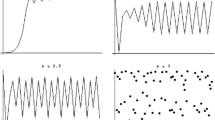Abstract
We explore conditions for productive synthesis between formal reasoning and intuitive representations through analysis of college students’ understanding of the limit concept in the definition of the derivative. In particular, we compare and contrast cognitive processes that accompany different manifestations of persistence of intuitions and tacit models that coexist with students’ logical reasoning. The students are highly trained in mathematics. We encounter expressions of the persistence and impact of intuitions and tacit pictorial models as described by Fischbein. But we also observe some new characterization of persistence of tacit models in which the tacit pictorial model continues to interfere in the student’s reasoning process, coexists with a logical reasoning but does not prevent the student from reaching a feeling of logical consistency. The empirical analysis and the theoretical discussion offered in the present paper permit us to highlight this very special integration of the formal and the intuitive components of the reasoning process.







Similar content being viewed by others
References
Cauchy, A. L. (1821). Cours d’analyse: Analyse algébrique [Course in analysis: Algebraic analysis]. Paris: De Bure.
Fischbein, E. (1978). Intuition and mathematical education. Osnabrücker schriften zur Mathematik, I, 148–176.
Fischbein, E. (1982). Intuition and proof. For the Learning of Mathematics, 3(2), 9–18.
Fischbein, E. (1987). Intuition in science and mathematics: An educational approach. Dordrecht: Reidel.
Fischbein, E. (1999). Intuitions and schemata in mathematical reasoning. Educational Studies in Mathematics, 38, 11–50.
Fischbein, E. (2001). Tacit models and infinity. Educational Studies in Mathematics, 48, 309–329.
Fischbein, E., Tirosh, D., & Hess, P. (1979). The intuition of infinity. Educational Studies in Mathematics, 10, 3–40.
Fischbein, E., Tirosh, D., Stavy, R., & Oster, A. (1990). The autonomy of mental models. For the Learning of Mathematics, 10(1), 23–30.
Kidron, I. (2008). Abstraction and consolidation of the limit procept by means of instrumented schemes: The complementary role of three different frameworks. Educational Studies in Mathematics, 69(3), 197–216.
Mariotti, M. A. (1993). The influence of standard images in geometrical reasoning. Proceedings of the 17th Annual Meeting for the Psychology of Mathematics Education (Vol. 2, pp. 177–182). Tsukuba, Japan.
Mariotti, M. A., & Fischbein, E. (1997). Defining in classroom activities. Educational Studies in Mathematics, 34, 219–248.
Monaghan, J. (2001). Young peoples’ ideas of infinity. Educational Studies in Mathematics, 48, 239–257.
Rota, G. C. (1997). Indiscrete thoughts. Boston: Birkhauser.
Stavy, R., & Tirosh, D. (1996). The role of intuitive rules in science and mathematics education. European Journal of Teacher Education, 19, 109–119.
Stewart, I. (2001). What shape is a snowflake. New York: W.H. Freeman.
Tall, D. (1999). Efraim Fischbein, 1920–1998, Founder President of PME—A Tribute. Proceedings of the 23th Annual Meeting for the Psychology of Mathematics Education (Vol. 1, pp. 3–5). Haifa, Israel.
Tall, D., & Tirosh, D. (2001). Infinity—the never-ending struggle. Educational Studies in Mathematics, 48, 129–136.
Tall, D., & Vinner, S. (1981). Concept image and concept definition in mathematics with particular reference to limit and continuity. Educational Studies in Mathematics, 12, 151–169.
Tirosh, D. (1990). Inconsistencies in students’ mathematical constructs. Focus on Learning Problems in Mathematics, 12, 111–129.
Tirosh, D. (1991). The role of students’ intuitions of infinity in the teaching of the Cantorian theory. In D. Tall (ed.), Advanced Mathematical Thinking (199–214). Dordrecht, The Netherlands: Kluwer.
Tsamir, P. (2001). When “the same” is not perceived as such: The case of infinite sets. Educational Studies in Mathematics, 48, 289–307.
Vinner, S., and Hershkowitz, R. (1980). Concept images and common cognitive paths in the development of some simple geometrical concepts. Proceedings of the 4th Annual Meeting for the Psychology of Mathematics Education (pp. 177–184). Berkeley, California, USA.
Acknowledgments
I presented a preliminary version of this research in Fischbein’s memorial lecture at Tel Aviv University, January 17, 2006. The research was supported by the Israel Science Foundation (grant number 843/09).
Author information
Authors and Affiliations
Corresponding author
Rights and permissions
About this article
Cite this article
Kidron, I. Tacit models, treasured intuitions and the discrete—continuous interplay. Educ Stud Math 78, 109–126 (2011). https://doi.org/10.1007/s10649-011-9313-6
Published:
Issue Date:
DOI: https://doi.org/10.1007/s10649-011-9313-6




